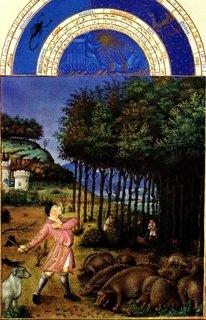 (click on image to enlarge.)
(click on image to enlarge.)The scene of November showing the acorn harvest, a traditional theme for this month, was executed entirely by Jean Colombe. The Limbourgs painted only the tympanum, which - as in the other eleven months - crowns the scene with signs centered around a semicircle painted in blue camaïeu (monochrome), in which a man carrying a brilliant sun, as one might present a monstrance, is enthroned on a chariot drawn by two horses. (This image of the sun chariot is taken from a medal, now in the Bibliothèque Nationale, representing the Emperor Heraclius returning the True Cross to Jerusalem. A copy of this coin belonged to the renowned collection of Jean de Berry.)
Above are astronomical signs and the signs of the zodiac for the month of November in blue camaïeu on a background of golden stars: Scorpio at left, Sagittarius at right. The Limbourgs probably painted the tympani for the various months all at one time.
Unlike the other scenes, this does not take place on a famous site that the artists were proud to evoke.The setting, painted with some talent, seems to be a figment of Jean Colombe's imagination, although it might have been inspired by the countryside of Savoie, where the artist completed the Tres Riches Heures for the Duc de Savoie. The different planes are picturesquely spaced, blending into the blue of the horizon where a sinuous river twists between the mountains. Nearer, the towers of a château and a village cling to the rocks. In front, a peasant dressed in a tunic with golden highlights draws back his arm and prepares to hurl a stick into an oak tree. At his feet, pigs greedily eat the fallen acorns under the watchful eyes of a dog.We see other peasants with their pigs under the trees. The scene is painted in muted tones that at first glance differentiate it from the other months but do not detract from it. It has an agreeable quality; only the animals do not have the muscular vigor that the Limbourgs were able to impart to their creatures on the following page.
I got interested in the events depicted in Emperor Heracleas, and its a whopper of a story! Please read chapter 46 of Gibbon's book! Wowsers! http://etext.library.adelaide.edu.au/g/gibbon/edward/g43d/chapter46.html
No comments:
Post a Comment